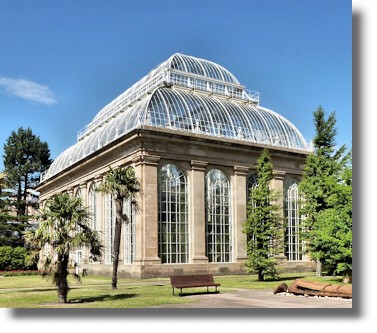History
The Royal Botanic Garden Edinburgh (RBGE) was originally founded in 1670 as Scotland's first physic garden, providing plants used for medicinal purposes by local physicians. It soon outgrew its original site near Holyrood Abbey and the Palace of Holyroodhouse at the foot of the Royal Mile. So the garden relocated and expanded out of the city centre in 1763 to a site on the road to Leith. This was achieved thanks to the work of a doctor, John Hope, who also indulged in botany in his spare time. Hope became King's Botanist and Professor of Botany and Materia Medica at the University of Edinburgh and the first Regius Keeper of RBGE. In 2010, the East Gate was enlarged into a smart visitor centre and renamed the "John Hope Gate" in his honour. The graphic on the right is a wind turbine on top of the gate.
The botanic gardens had moved to this site at Inverleith in 1820, transplanting the entire collection using specially designed machines over a period of three years.
The new Garden expanded in later years from that original area, gaining the grounds of Inverleith House and also another area for the Rock Garden. Scottish plant hunters in the 19th and early 20th centuries were among the foremost in the field and more than 10,000 specimens were added between 1905 and 1932.
The garden in Edinburgh now extends to over 70 acres of landscaped grounds, green houses, a visitor centre and three locations providing food and drink, all conveniently located just one mile from the city centre. It is thus within walking distance of Princes Street, passing the Water of Leith on the way.
Special Areas
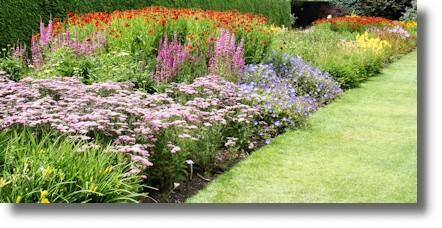
Perhaps the most striking feature in the garden, particularly in the summer, is the extensive herbaceous border. It is 165 metres (540 feet) long and is sheltered by a tall, impressive beech hedge which was planted over 100 years ago and is formed from 150 individual beech trees. As in other parts of the garden many of the flowering plants have identification labels which help those who are not experts to learn the names of plants that they may want to grow in their own garden.

For many years, the Royal Botanic Garden, Edinburgh (RBGE) has had links with the Lijiang Botanic Garden in China and in 1993 RBGE established a "Chinese Hillside" displaying in a tranquil corner many of the Edinburgh collection of Chinese plants with a stream, pond, bamboo groves, bridges and typical Chinese flowers such as ligularia. The RBGE has the largest collection of wild plants from China outside of that country.
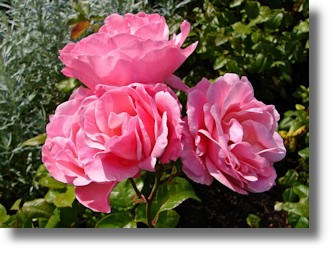
In 2006, as a tribute to Queen Elizabeth, the Queen Mother (1900 – 2002), RBGE established a memorial garden with plants and layout that have a connection to the popular royal. The "Queen Mum" personally tended the garden at her residence in Scotland at the remote Castle of Mey in Caithness. So there are lots of roses (including the one named after her "Queen Elizabeth"), lilies, stately delphiniums and the oversize Matiliija Poppy. In the centre of the garden is a labyrinth planted with bog myrtle, arranged in the form of a series of interlocking "E"s for Elizabeth. Bog myrtle is common in the Scottish Highlands and is also highly ornamental in spring and autumn. It is also a traditional ingredient of Royal Wedding bouquets and is used also in perfumery and as a condiment. In Scotland myrtle has been traditionally used to ward off the dreaded midge.
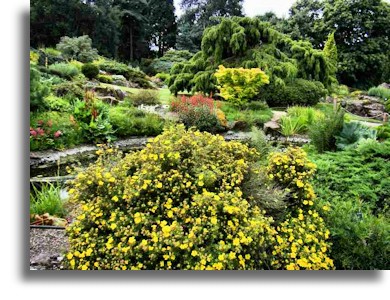
The area dedicated to the rock garden is near the Inverleith Row entrance to the garden and is set on a hillside with a stream running through it. The rock garden is world-famous and has around 5,000 plants in it although many can be quite small.In spring the botanic garden has an impressive display of 400 species of wild origin rhododendrons - this plant thrives in the Scottish climate and acid soil. And throughout the year, the specimen trees, particularly in the Arboretum soar into the sky - including giant Sierra redwoods from North America and numerous others, including Monkey Puzzle, beeches, maples, magnolias, chestnut, cedar and colourful rowans (Mountain Ash) - the latter has become particularly associated with Scotland, due in part to the belief that it was an aid in warding off of witches. As a result the tree was often planted near a gate or front door. In total, there over 1,800 trees in the RBGE.
Palm House and Glasshouses
Visible from many aspects of the garden is the impressive Temperate Palm House, the tallest of its kind in Britain. It was built in 1858 and had a major make-over in 2005. It houses the Garden's oldest palm which was already mature when it was moved from the previous Leith Walk site in 1822. The Palm House is also the entrance to the "Windows on the World" - a series of ten glass houses (and a small aquarium) kept at different levels of temperature and humidity to suit the different types of plants on display in each one. They accommodate a significant number of flowering plants, cycads and ferns, including banana, rubber and the world's largest collection of tender vireya rhododendron, originating from the mountains of New Guinea and Borneo. Although the rest of the huge botanic gardens are free of charge, there is an entrance fee to defray the high cost of maintaining and heating these glass houses.
Visitor Centre and Eating Places
The redesigned second main entrance at the West Gate from Arboretum Walk was formally opened in 2010 and named "John Hope Gateway" after the first Regius Keeper of RBGE. It incorporates a visitor centre and display area and a restaurant (licensed and table service). There is an article on the new gateway on this site at Tam's Tales - New Hope Gateway to Edinburgh's Royal Botanic Garden .
Inverleith House in the centre of the botanic garden has a Terrace Cafe offering self service meals, snacks and drinks while East Gate Lodge has a Coffee Bar and snacks. A proportion of the profits from these outlets support the work of the RBGE which is a charity, dependent on donations. Entrance to the gardens is free - though there are collection boxes for those who want to make a donation to help support the work of the organisation.
Slide Show of Pictures from the Garden
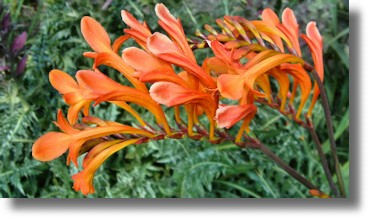
Although this page has a number of illustrations there is also a slide show illustrating nearly sixty of the flowers, plants, trees and views at the Royal Botanic Gardens Edinburgh at Royal Botanic Gardens Edinburgh - Slide Show.
